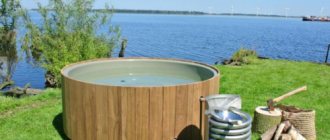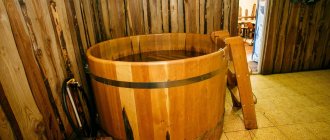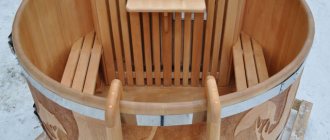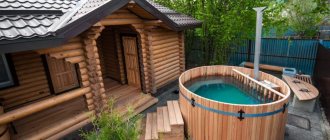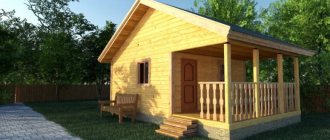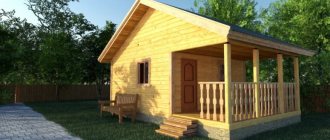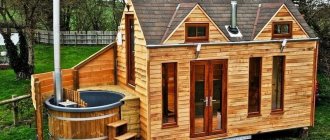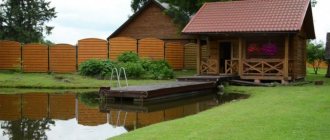Our grandparents knew about the beneficial qualities of outdoor baths. Almost every rural house always had a font or bathhouse. This is a guarantee of health, as well as an excellent way to have a good and useful time and take water treatments. Complete rest and pleasant surroundings can be available to you at any time of the year.
Building a hot tub yourself is not that difficult! You will find everything you need for this to be relatively accessible. The price and costs of materials will pleasantly surprise you, because the font will cost you relatively little!
Types of heated baths
Font with polypropylene bowl
The finished hot tub is rich in a variety of design variations. Generally speaking, it consists of external wooden cladding, a polypropylene bowl, a small platform for the floor, and a ladder. If the material is wood, then preference is given to oak, pine and spruce.
Wooden font
Instead of a polypropylene bowl, you can use a cheaper option - a wooden font with ties. Possible difficulties with this option are that the wooden structure requires more careful maintenance. Wood can dry out, crack and leak, and therefore need repair more often. When purchasing such a bowl, be sure to pay attention to its impregnation and processing. All parts and the body must be carefully treated with materials such as wax and varnish. Conscientious coating with wax and varnish reduces the risk of cracks.
Font made of stainless materials
Another interesting option are bathtubs made of stainless materials. Sheets of steel are processed and given any bath shape. It is possible to combine it with different types of cladding, which will fit into any interior of a country house or garden area. In addition, a stainless steel bowl is more durable in use; it can be either deepened into the ground, aligned with the ground level, or placed on “legs” to be heated using a stove or fire. The only recommendation for heating the font yourself is to sprinkle the bottom with a small layer of pebbles. This is necessary to distribute the temperature to avoid possible burns.
Comparative characteristics
Wooden containers have the advantage of natural wood. These are baths that have a unique aroma and effect. However, these undoubtedly positive qualities are neutralized when using the cold font. Cold wood does not sufficiently saturate the air with its aroma; you will not be there for a long time and will not have time to enjoy the naturalness of your bowl.
Here, the disadvantages of wooden containers come to the fore: susceptibility to putrefactive processes, drying out during periods of inactivity, mini-leaks, and the need for constant careful maintenance.
Metal vats vary in size, weight, and shape. Stainless steel containers are lighter and easier to clean, but have thinner walls and retain heat less well than thick-walled cast iron ones. The distinctive properties of cast iron bowls are their heavy weight and fragility to impact. They are distinguished from wooden ones by a longer service life. However, in aesthetics they are inferior to both wooden and plastic models.
Concrete fonts are homemade containers that are more like a mini-pool in size. They are installed permanently on the street or in a separate room of the bathhouse. Concrete containers are an expensive option because they require additional waterproofing and aesthetic design. Here, a combined option is more common, when concrete formwork is arranged for a polymer font-liner.
Plastic and composite hot tubs do not have the disadvantages of wooden containers. They are not subject to rotting, have a significant service life, are easy to maintain and can be installed both indoors and outdoors. Plastic ones are made from organic polymers, while composite ones have fiberglass additives in the polymer, which makes them especially durable. The variability of sizes, shapes and colors is limited only by your capabilities and imagination. Any font will be made to order.
Operating rules
Remember, wooden hot tubs are extremely capricious and do not perform well without prolonged use. So periodically warm up the hot tub completely.
In summer, you can leave 5-10 cm of water in the bowl to avoid drying out. In winter, it is not recommended to leave water. It is better to maintain the density of the boards, in order to avoid destruction by ice, to use a layer of clean snow in a covering of 15-20 cm.
To better preserve the font, change the water every 3-4 days. The heating temperature of the hot tub should not exceed 40 ˚С.
How to build a font yourself
So, we found out what kind of font you can buy and how to care for it. But, unfortunately, the cost of the hot tubs offered in stores sometimes far exceeds the officially announced average annual salary. Let's consider a budget option for arranging a font with your own hands.
Please note that installing a hot tub yourself requires some knowledge in plumbing and construction. It will not be possible to put together a font on your knee from what you have at hand. You need appropriate materials and tools.
Consider the location, comfort, drainage and heating, the location of the railings, flooring, handles and rim. In other words, approach the construction not only with creativity, but also with practicality.
However, it is better to order a ready-made bathtub and cover it yourself. It will be much cheaper, and you will enjoy working with your own hands. Of course, the font is not a replacement for a Russian bathhouse or swimming pool. This is an additional opportunity to take spa treatments in the fresh air at any time of the year and at contrasting temperatures.
Choose materials not for cheapness, but for quality, with the expectation that this design will serve you for more than one season.
Types of outdoor hot tubs
Outdoor spa pools and hot tubs are manufactured by various companies.
They differ in purpose, materials of manufacture, shape and size. In total, there are 3 main groups of such hydromassage baths. Inflatable. They are very easy to install, take up little space on the site, and their price is not bad at all. Of course, unlike portable and stationary models, they do not look as presentable, but with the correct design of the recreation area, they fit harmoniously into the landscape.
Interested in inflatable hot tubs? You can find detailed information about the pros and cons, as well as a review of manufacturers, in our special article.
Stationary. These models go deep into the ground during installation. The entire hydraulic system that ensures the functionality of the product is located under the bowl or in the technical room. Depending on the circulation of water, stationary models are divided into: overflow (they have a simpler design, there is no high pressure) and skimmer (water is supplied under pressure through nozzles).
They can be used all year round. This is very useful since most people like to enjoy swimming in hot tubs when there is already snow all around.
Portable. They are installed outdoors or indoors - the main thing is that communications can be made. If desired, they can be used outdoors even in winter, as they are heated.
Such fonts combine mobility and solidity. They are installed in the garden, on terraces, balconies and even on the roofs of country houses. Of course, they are not so easy to transport, unlike inflatable ones. But it is possible to periodically change the location of the bowl on the site.
When swimming in a spa pool in winter, you can choose the optimal water temperature, because... All of them are equipped with heating. Most models are equipped with thermally insulating protective covers - covers that play an important role when operating in cold weather.
Making a font or mini-ice hole
Let's consider the simplest option, which a home craftsman can do. To do this, it is enough to have minimal plumbing and carpentry skills.
Necessary materials
- IBC is a container for 1000 liters, commonly called a Eurocube, which has a metal sheathing;
- siding strip, external corner, 4 pieces, 1.2 m each;
- siding;
- hardware, fasteners;
- lining, leftovers of 1.1-1.2 m each, 8 pcs.
Operating procedure
Cut off the top of the polymer container along with part of the metal sheathing.
Install strips in the corners, the outer corner, and cover with siding.
The top of the tank is finished with clapboard pre-treated with moisture-repellent agents.
We build stairs or steps. The photo shows a version of steps made of logs. Treat the logs and paint them the same color as the lining.
As a rule, an IBC container is equipped with a tap at the bottom. This is convenient both for draining water and for filling the container using a pump and hose.
DIY "boiler"
To heat the water in the font, you can buy gas or electric instantaneous water heaters. But we will look at a simple-to-use and mobile water heating system.
We will need:
- a metal tank with a lid for boiling laundry, commonly called boiling water, or a 15-liter bucket;
- copper tube ᴓ15 mm;
- 2 PVC pipes of suitable diameter;
- low voltage circulation pump;
- 12 V power supply (Battery).
Algorithm of actions
From a metal tank we construct a “Firebox” with an ash pit. The “grid-iron” can be constructed from the bottom of a zinc bucket of suitable size or from a metal sheet with holes. In the tank, 1-2 cm above the bottom, drill several holes for air flow.
Place the “grid” in the firebox so that there is a gap of 3-4 cm between the bottom of the tank and the “grid”. Make a hole in the tank above the grate into which a copper tube is threaded.
We make a heating circuit from copper wire. To do this, we place the copper tube, turn by turn, tightly around an object of suitable size. To prevent the tube from breaking or becoming deformed during operation, fill it with regular kitchen salt. Subsequently, the salt will dissolve and flow out with the water.
We place the formed contour in the firebox, and thread the lower end of the copper pipe into the hole above the “grid”. We bring the upper copper end directly into the font.
We connect the lower end of the copper tube through an angle adapter and a PVC pipe to the circulation pump. We attach the second PVC tube to the pump, and lower the other end into the water of the font.
Burning coals are placed in the firebox, and more fresh coal is added on top. To improve traction, you can additionally supply air into the “blower” through a piece of metal tube using a regular aquarium compressor.
The coals burn and heat the copper circuit, through which a pump drives water from and into the font. A mobile and fairly efficient boiler is ready.
The flight of creative thought is limitless. The photo shows an example of a very creative version of a heated font.
Choose your option that is right for you, and be healthy!
Boiler diagram
Various types of structures are used to heat water in the pool. The devices consist of a firebox, a heat exchanger, a housing and a chimney.
Metal units are mobile, have high efficiency, and do not require a solid foundation.
The simplest homemade device for heating water in a pool is a metal cylinder, inside of which a heat exchanger is laid along the walls: a stainless steel coil. Firewood is burned inside, water is supplied by a pump or flows itself into the pool located nearby.
Photo 1. To make a pool heater, you need a similar coil: this is a heat exchanger through which the coolant will circulate.
A metal potbelly stove with a built-in heat exchanger is more difficult to make, but it is more efficient. The firebox is located under a heat exchanger, which can be a mesh of welded pipes, a coil, ribs of cast iron batteries, or automobile radiators with sparse plates. Hot gases passing through the heat exchanger heat the circulating liquid.
In boilers based on the Buleryan long-burning stove, all the fuel is used to heat the passing water. Home craftsmen have long learned to make such devices from profile pipes and sheet metal.
